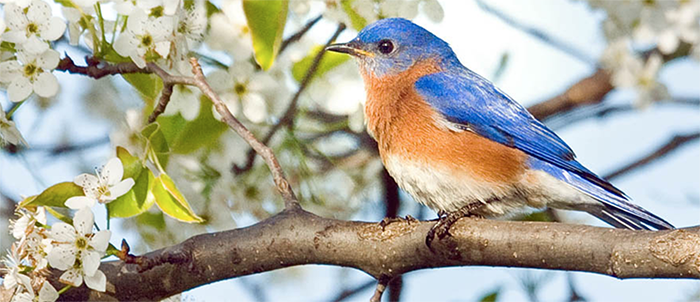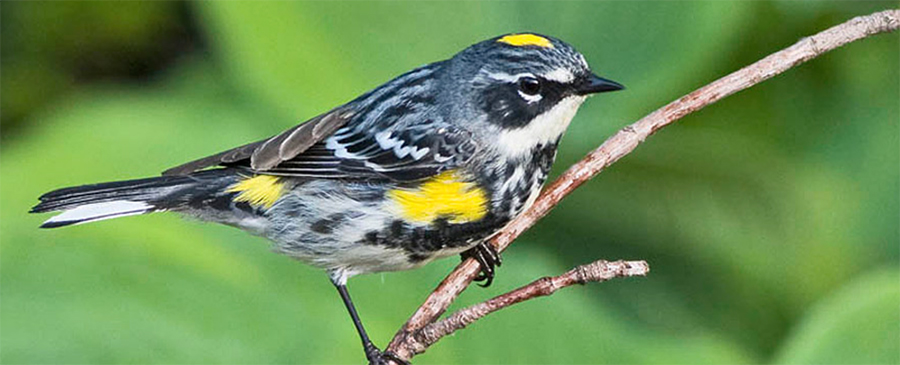Muttonhunk Fen Natural Area Preserve
In Brief: A recent addition to the Natural Area Preserve program, this mostly accessible property consists of shrub-scrub habitat maintained for nesting and migratory birds, as well as a hidden bog-like fen, currently not open to the public.
Access: Open daily, dawn to dusk (open gate manually if it is closed, and close and latch it after passing through). No restroom facilities. Please visit the Virginia DCR website for more information regarding potential closures due to management activities: Muttonhunk Fen
Virginia DWR Bird and Wildlife Trail: Muttonhunk
EVERYTHING YOU NEED TO KNOW ABOUT BIRDING MUTTONHUNK FEN NATURAL AREA PRESERVE
Eastern Bluebird, Photo: Robert W. Schamerhorn
Bounded by Gargathy Bay on the east and White’s Creek and Mutton Hunk Branch on the north, Muttonhunk Fen Natural Area Preserve (516 acres) holds a complete range of shrub-scrub nesting species known on the Eastern Shore, on 220 acres of land that was previously devoted to agriculture. However, the land conservation effort in this case was mostly owing to a hidden “sea-level fen community,” a very rare freshwater bog-like habitat tucked between uplands and tidal marshes. Here, in the acidic and nutrient-poor conditions of this habitat, rare plants are found that occur nowhere else on the Virginia Eastern Shore, such as Brown-fruited Rush (Juncus pelocarpus) and Titi (Cyrilla racemiflora). Other species of note include White-top Fleabane (Erigeron vernus), Ten-angle Pipewort (Eriocaulon decangulare), Saltmarsh Spikerush (Eleocharis halophila), Beaked Spikerush (E. rostellata), White Beakrush (Rhynchospora alba), and Southern Bladderwort (Utricularia juncea). Access to the fen itself is currently restricted to scientists with permits, but there are two trails open to the public: the main road, which ends at Gargathy Bay, and a trail that follows White’s Creek.
During spring and summer, birders enjoy eye-level views of many widespread nesting species here, among them Indigo Bunting, Blue Grosbeak, Northern Cardinal, Orchard Oriole, Yellow-breasted Chat, Prairie Warbler, Common Yellowthroat, White-eyed Vireo, Brown Thrasher, Eastern Bluebird, Eastern Kingbird, Field Sparrow, Grasshopper Sparrow, and Blue-gray Gnatcatcher. Occasionally, a Dickcissel is found in spring, but most records here are from fall migration, as is also true of Bobolink. Adjacent woodlands, along White’s Creek, hold Ovenbird, Summer Tanager, Pine Warbler, Hooded Warbler, Eastern Wood-Pewee, Acadian Flycatcher (in wet spring seasons), Red-eyed Vireo, and Yellow-throated Warbler.
Yellow-rumped Warbler, Photo: Robert W. Schamerhorn
Spring migration is little canvassed here, but one fortunate observer located an ultra-rare Loggerhead Shrike 5-9 May 2018, and scarce warblers such as Black-throated Green, Wilson’s, and Cape May have turned up, along with Scarlet Tanager, White-crowned Sparrow, and a rare Scissor-tailed Flycatcher. Autumn regularly produces Clay-colored Sparrows here (up to 3 together have been seen), with a few records of migrants like Black-billed Cuckoo, Rose-breasted Grosbeak, and Chestnut-sided Warbler to whet the curiosity. Check the small ponds near the orientation shelter for Common Gallinule in October through December. Orange-crowned Warbler appears in October and stays through April most years. The end of the main trail, at Gargathy Bay, is a fine place to watch for a variety of herons, egrets, ibises, rails (including Virginia), shorebirds (20 species), gulls, terns, Black Skimmer, and waterfowl in season.


